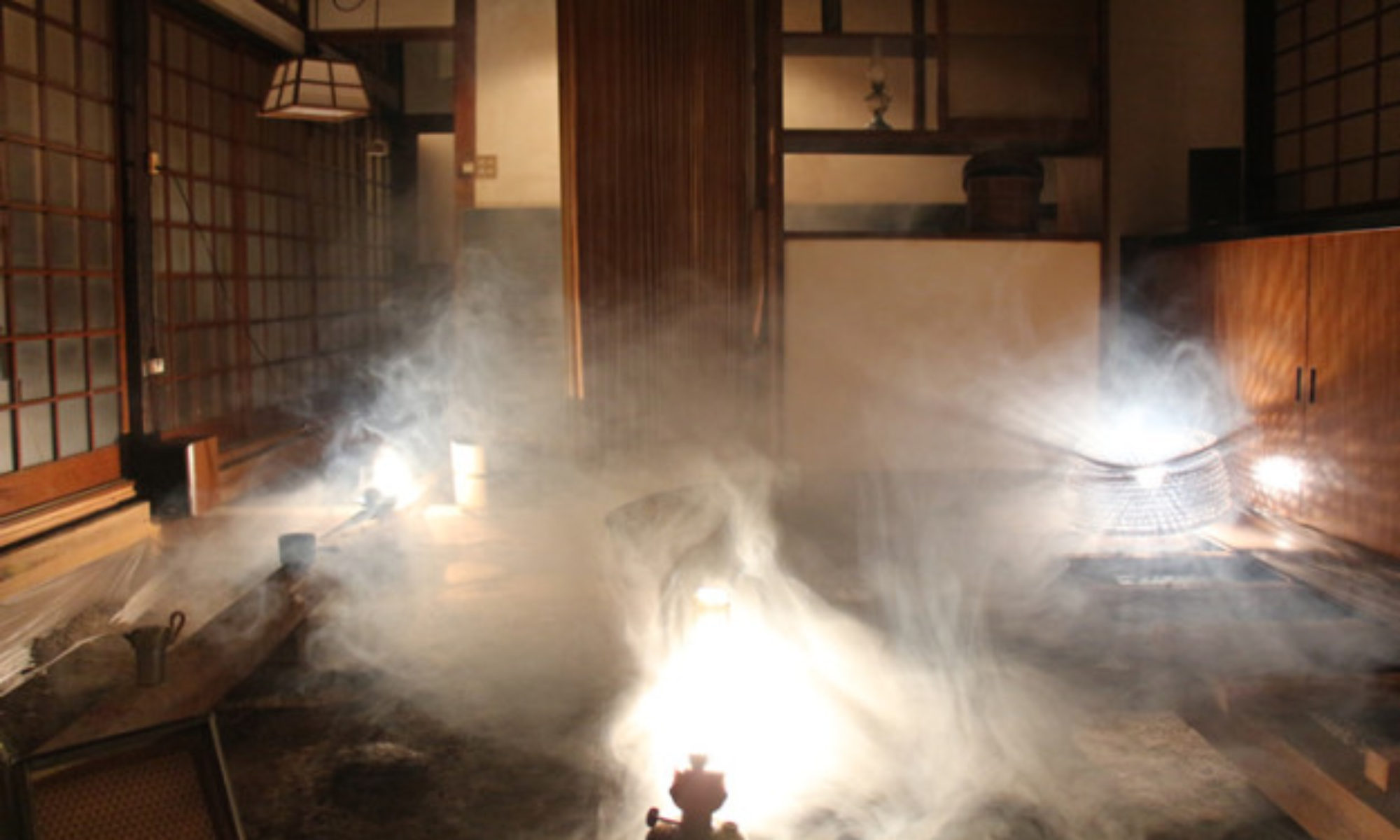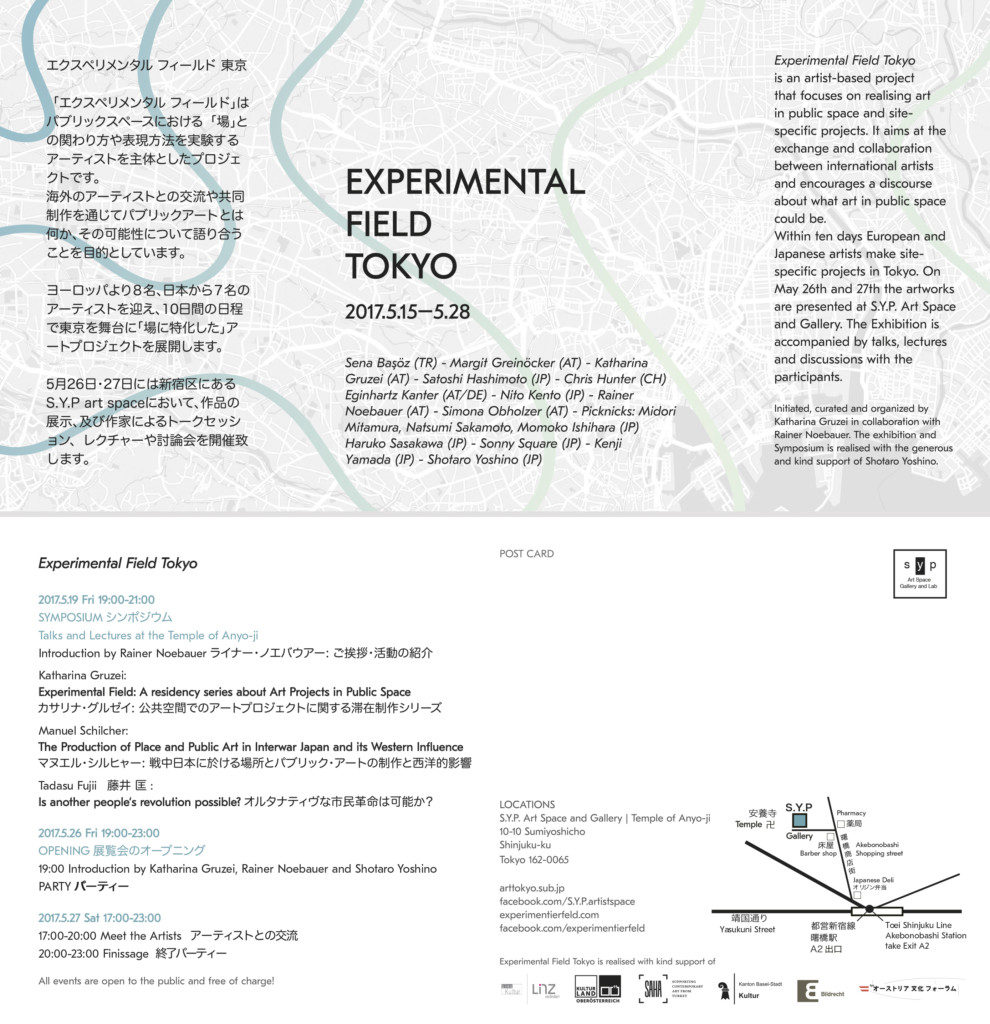EXPERIMENTAL FIELD TOKYO – EXHIBITION
Sena Başöz (TR) – Margit Greinöcker (AT) – Katharina Gruzei (AT) – Satoshi Hashimoto (JP) – Chris Hunter (CH) – joechlTRAGSEILER (AT) – Eginhartz Kanter (AT/DE) – Nito Kento (JP) – Rainer Noebauer (AT) – Simona Obholzer (AT) – Picknicks: Midori Mitamura, Natsumi Sakamoto, Momoko Ishihara (JP) – Haruko Sasakawa (JP) – Sonny Square (JP) – Kenji Yamada (JP) – Shotaro Yoshino (JP)
Initiated, curated and organized by Katharina Gruzei in collaboration with Rainer Noebauer. The exhibition and Symposium is realised with the generous and kind support of Shotaro Yoshino.
2017.5.26 Fri 19:00-23:00
OPENING
19:00 Introduction by Katharina Gruzei, Rainer Noebauer and Shotaro Yoshino
Opening Speech by Daisuke Harada
2017.5.27 Sat 17:00-23:00
FINISSAGE + MEET and GREET
17:00-20:00 Meet the Artists アーティストとの交流
20:00-23:00 Finissage 終了パーティー
All events are open to the public and free of charge!
EXPERIMENTAL FIELD TOKYO
2017.5.15 – 5.28
“Experimental Field Tokyo” is an artist-based project that focuses on realizing art in public space and site-specific projects. It aims at the exchange and collaboration between international artists and encourages a discourse about what art in public space could be.
Within ten days European and Japanese artists make site-specific projects in Tokyo. On May 26th and 27th the artworks are presented at S.Y.P. Art Space and Gallery. The Exhibition is accompanied by talks, lectures and discussions with the participants.
エクスペリメンタル フィールド 東京
2017.5.15 – 5.28
「エクスペリメンタル フィールド」はパブリックスペースにおける「場」との関
海外のアーティストとの交流や共同制作を通じてパブリッ
ヨーロッパより8名、日本から7名のアーティストを迎え
Experimental Field Tokyo is an artist-based project that focuses on realizing art in public space and site-specific projects. It aims at the exchange and collaboration between international artists and encourages a discourse about what art in public space could be. Within ten days European and Japanese artists make site-specific projects in Tokyo. On May 26th and 27th the artworks are presented at S.Y.P. Art Space and Gallery. The Exhibition is accompanied by talks, lectures and discussions with the participants.
PROGRAM
2017.5.19 Fri 19:00-21:00 S.Y.P 奥 安養寺にて
SYMPOSIUM シンポジウム Talks and Lectures at the Temple of Anyo-ji (Next to S.Y.P)
Introduction by Rainer Noebauer
ライナー・ノエバウアー: ご挨拶・活動の紹介
Katharina Gruzei: Experimental Field: A residency series about Art Projects in Public Space
カサリナ・グルゼイ: 公共空間でのアートプロジェクトに関する滞在制作シリー
Manuel Schilcher: The Production of Place and Public Art in Interwar Japan and its Western Influence
マヌエル・シルヒャー: 戦中日本に於ける場所とパブリック・アートの制作と西洋
Tadasu Fujii: Is another people‘s revolution possible?
藤井匡:オルタナティヴな市民革命は可能か?
All events are open to the public and free of charge!
SYMPOSIUM PROGRAM SYNOPSIS
*english version below*
ライナー・ノエバウアー – ご挨拶・活動の紹介
ライナー・ノエバウアーさんが観客を歓迎し、エクスペリ
ライナー・ノエバウアー: 1979年生まれ。リンツ工科造形芸術大学を卒業。エク
– – –
カサリナ・グルゼイ- 「エクスペリメント・フィールド: 公共空間におけるアートプロジェクトの滞在制作シリーズ
カサリナ・グルゼイさんにプロジェクトの指針に関する概
カサリナ・グルゼイ:1983年生まれ。リンツ工科造形
– – –
マヌエル・シルヒャー: 戦中期の日本における「場所」の創造と「パブリック・ア
16世紀以降、日本ではさまざまな公共展示の方法が確立
20世紀初頭に百貨店の勃興により、見世物は路地からデ
マヌエル・シルヒャー:1966年生まれ。リンツ工科造
– – –
藤井匡:オルタナティヴな市民革命は可能か?
日本の近代化に関して、二つの象徴的な出来事が寺院の空
建畠晢(美術評論家)は、日本における公共性という概念
現状への対抗として、建畠は美術館が「緩慢なる市民革命
藤井匡:1970年生まれ。九州大学文学部哲学科美学美
SYMPOSIUM PROGRAM SYNOPSIS – english version
Rainer Noebauer – Introduction
Rainer Noebauer will welcome the audience and give an introduction to the Experimental Field Symposium.
Rainer Noebauer, born 1979 graduated from the University of Arts and Design Linz. He is the founder of the Experimental Field Series and works as an artist and curator in Austria and abroad.
– – –
Katharina Gruzei – Experimental Field: A residency series about Art Projects in Public Space
Katharina Gruzei will provide an overview of the principles of the project. Experimental Field is an artist-based project that focuses on realizing art in public space and site-specific projects. It aims at the exchange and collaboration between international artists and encourages a discourse about what art in public space could be. Katharina Gruzei will introduce this artist based initiative and show artworks that have been produced in previous editions of the Experimental Field series. So far Experimental Field has taken place in the Netherlands, Germany, Austria and Switzerland. Her lecture will give an insight to the various approaches of artists working in public space, realising site-specific projects or developing artwork in relation to the public sphere.
Katharina Gruzei, born 1983 graduated from the University of Arts and Design Linz. She initiated, curated and organised Experimental Field Tokyo in collaboration with Rainer Noebauer. She currently has a residency in Tokyo from the Austrian Government.
– – –
Manuel Schilcher – The Production of Place and Public Art in Interwar Japan and its Western Influence.
Since the 16th century onward different methods of public display were established in Japan. Until the transformation of the Western concept of museum, objects were presented in the temporary unveiling of sacred icons called kaicho, the educational displays of Dutch science objects and texts called bussankai and the spectacles and curio shows called misemono. Mostly located around temples and shrines this venues were outside of governmental restrictions and control, motivated to create a form of public space distinct from the state, floating between religion, commerce, sex and entertainment.
With the rise of department stores in the early twentieth century misemono moved from the street into the show windows of the stores. Those were decorated with realistically created mannequins iki-ningyo and three dimensional decoration objects uridashi gaito soshoku, following Germans Bauhaus design plastics, to generate more attention and revenue for customers. In their commercial success of promoting art, department stores became an early part of modern exhibition practice as those institutions changed also the presentation technique of framed paintings at their art sections.
Comparing the German Bauhaus and Russian Constructivism with the Japanese proletarian art forms, the speech will focus on the first urban Avantgarde sculptures and performances which were brought to the streets in Tokyo after the Kanto Earthquake in 1923. In an historical overview on the conception of presenting art, the lecture will discuss intercultural differences in the use of public space between Japan and Europe. Furthermore the methods of display in department stores and temples will be questioned and compared from a Western point of view.
Manuel Schilcher, born in 1966 graduated from the University of Arts and Design Linz. He is working as exhibition designer, curator and artist in Austria and Japan. His recent work focuses on the design of remembrance in East Asian museums, the role of the visual arts in the construction of modern national identity and the entanglements to NSGermany to Japan. He is currently working on his PhD thesis titled “How do artists go to war: An intercultural view on the construction of Japanese history.”
– – –
Tadasu Fujii – Is another people´s revolution possible?
At the time of modernization in Japan, two symbolic events occurred in the space of the temple. One is Japan’s first exposition held at the Yushima Confucius Temple in 1872, and the other is the legislation of Park Law promulgated by Dajō-kan, the Great Council of Japanese Imperial government in 1873. The former displayed works which were planned to present in Vienna Exposition in the following year, and this led to the birth of Tokyo National Museum. The latter transformed traditional Senso-ji Temple and Kanei-ji Temple into current Asakusa-koen Park and Ueno-koen Park. Even if the space of the temple of the Edo era had an important social role, and it is right that it has affected the current Japanese public space, it is not a place opposed to the state power.
Akira Tatehata who is an art critic relates the absence of the concept of the publicity in Japan to absence of the people’s revolution such as the West. Actually, many Japanese understand the National Museum as “the government’s museum” not “the citizen’s museum”. The public space is the same, too. It is difficult to discuss publicity as a certain thing. As opposition to present conditions, Tatehata suggests that museums practice “gradual people’s revolution”. Similar practice is necessary for the public space. But it is impossible that “gradual people’s revolution” takes the style of the revolution of the Western model. Is another people’s revolution possible? I consider this using the example of some art projects that I participated in.
Tadasu Fujii, born in 1970, graduated from Kyushu University. He worked as a committee member of numerous Art awards for public art and monumental art, and taught in many universities as a guest researcher/ adjunct lecturer. He is currently work as an associate professor in Tokyo Zokei University as well as a director of NPO corporation ‘Contemporary Art Japan’. He is an author of two books, “Methods of Contemporary Sculpture” in 2014, and “Art in Public Space” in 2015. He is also an co-author of “Narita Katsuhiko-Ember of Mono-ha and longing for painting” in 2017.
LOCATIONS
S.Y.P. Art Space and Gallery | Temple of Anyo-ji
10-10 Sumiyoshicho
Shinjuku-ku
Tokyo 162-0065
http://arttokyo.sub.jp/
facebook.com/
experimentierfeld.com
facebook.com/

